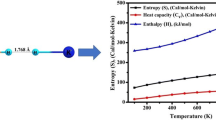Abstract
In this paper we carried out a systematic study in order to assess the quality of some semiempirical methods (AM1, PM3 and PM6), comparing predicted structural properties of many Sb(III) and Bi(III) complexes with the corresponding experimental data, indicating which one is more appropriate to describe the structure of such compounds. Root-mean squared deviation (RMSD) and unsigned mean error (UME) were used to evaluate the accuracy of the semiempirical methods to predict the ground state geometries of complexes with many ligand types. Our results have shown that, in general, PM3 predicts more accurately the geometry of Sb(III) complexes, being considered by us as the method of choice to study Sb(III) complexes with a great variety of ligands. PM6 is indicated as the method of choice to study Bi(III) complexes with many types of ligands and also to study Sb(III) thiocompounds, even though PM6 showed an inability to reproduce Sb-N bonds for complexes with flexible ligands, presenting an average deviation of 71.5 % compared the X-ray data.









Similar content being viewed by others
References
Silvestru C, Breunig H, Althaus H (1999) Chem Rev 99:3277–3327
Sanderson J, Basey CA (2008) Tetrahedron 64:7685–7689
Yang N, Sun H (2011) in: Sun H (ed) Biological chemistry of antimony and bismuth. Wiley, New York
Sun H, Ge R (2007) Acc Chem Res 40:267–274
Ilari A, Baiocco P, Colotti G, Franceschini SJ (2009) Med Chem 52:2603–2612
Ozuturk II, Handjikakou SK, Hadjiliadis NKN, Kubicki M, Baril M, Butler IS, Balzarini J (2007) Inorg Chem 46:8652–8661
Ozuturk II, Hadjikakou SK, Hadjiliadis N, Kourkoumelis N, Kubicki M, Tasiopoulos AJ, Scleiman H, Barsan MM, Butler IS, Balzarini J (2009) Inorg Chem 48:2233–2245
Nomiya K, Kasuga NC, Onodera K, Nakano S, Hayashi K (2006) J Inorg Biochem 100:1176–1186
Andrews PC, Frank R, Junk PC, Kedzierski L, Kumar I, Maclellan JG (2011) J Inorg Biochem 105:454–461
Hassfjell S, Brechbiel MW (2001) Chem Rev 101:2019–2020
Sun H, Yang N (2007) Coord Chem Rev 251:2354–2366
Briand GG, Burford N, Eelman MD, Aumeerally N, Chen L, Carmeron TS, Robertson KN (2004) Inorg Chem 43:6495–6500
Asato E, Katsura K, Mikuriya M, Fujii T, Reedijk J (1993) Inorg Chem 32:5322–5329
Tiekink ERT (2002) Crit Rev Oncol Hematol 42:217–224
Mahajan K, Swami M, Singh RV (2009) Russ J Coord Chem 35:179–185
Boitrel B, Halime Z, Balieu S, Lachkar M (2007) C R Chim 10:587–589
Comba P, Hambley TW (2001) Molecular Modeling of Inorganic Compouds. Wiley-VHC, Weinheim
Hoge B, Boatz JA, Hegge J, Christe KO (1999) Inorg Chem 38:3143–3149
Bachmann C, Frapper G (2008) Chem Phys Lett 457:292–297
Poleshchuk OK, Shevchenko EL, Branchadell V, Frenking ML (2005) Int J Quantum Chem 101:869–877
Virko S, Petrenko T, Yaremko A, Wysokinski R, Michalska D (2002) J Mol Struct:Theochem 582:137–142
Yurchenko SN, Breidung J, Thiel W (2005) Theor Chem Acc 114:333–340
Karttunen AJ, Linnolahti M, Pakkanen TA (2011) Theor Chem Acc 129:413–422
Pye CC, Gunasekara M, Rudolph WW (2007) Can J Chem 85:945–950
Kuznetsov AM, Shapnik MS, Masliy AN, Zelenetskaya KV (2002) Russ J Electrochem 38:669–675
Wadt WR, Hay PJ (1985) J Chem Phys 82:284
Poleshchuk OK, Koput J, Latosinska JN, Nogaj BJ (1996) J Mol Struct 380:267–275
Stewart JJP (1991) J Comput Chem 12:320–341
Pankratov AN, Uchaeva IM (2002) Phosphorus. Sulfur Silicon Relat Elem 177:2611–2621
Pankratov AN, Uchaeva IM (2002) Phosphorus. Sulfur Silicon Relat Elem 177:791–802
Stewart JJP, MOPAC 2009 version 9.069W; Stewart Computational Chemistry. http://OpenMOPAC.net
Allen FH (2002) Acta Crystallogr Sect B 58:380–388
Scott DW (1979) Biometrika 66:605–610
Stewart JJP (2007) J Mol Model 13:1173–1213
Thiel W, Voityuk AA (1996) J Phys Chem 100:616–626
Thiel W, Voityuk AA (1992) Theor Chim Acta 81:391–404
Thiel W, Voityuk AA (1992) Int J Quantum Chem 44:807–829
Seitz M, Alzakhem N (2010) J Chem Inf Model 50:217–220
Stewart JJP (1989) J Comput Chem 10:209–220
Acknowledgments
We appreciate the financial support from CNPq (Conselho Nacional de Desenvolvimento Científico e Tecnológico) and CAPES (Coordenação de Aperfeiçoamento de Pessoal de Nível Superior), Brazilian agencies, and INCT-INAMI (Instituto Nacional de Ciência e Tecnologia - Nanotecnologia para Marcadores Integrados). We also wish to thank CENAPAD/SP (Centro Nacional de Processamento de Alto Desempenho) at Campinas, Brazil, for having made available to us their computational facilities Finally, we gratefully acknowledge the Cambridge Crystallographic Data Centre for the Cambridge Structural Database.
Author information
Authors and Affiliations
Corresponding author
Electronic supplementary material
Below is the link to the electronic supplementary material.
ESM 1
(DOC 3246 kb)
Rights and permissions
About this article
Cite this article
Martins, E.P.S., Rocha, G.B. Performance assessment of semiempirical molecular orbital methods in the structural prediction of Sb(III) and Bi(III) complexes. J Mol Model 19, 4575–4584 (2013). https://doi.org/10.1007/s00894-013-1974-x
Received:
Accepted:
Published:
Issue Date:
DOI: https://doi.org/10.1007/s00894-013-1974-x




